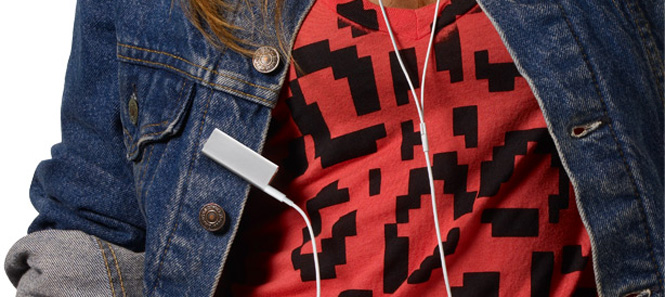
It may seem like a funny question to ask in the age of nanotechnology, but here it goes anyway: Can a gadget be too small?
Most of you are probably saying “no, the smaller the better” reflexively – and I can’t say I rightly blame you, given that in most cases, it’s the wisest default answer. But I’m getting a little fed up with the notion that, as a rule of thumb, smaller is always better in the technology industry. It’s a trend that seems to be widely accepted, but in many cases requires sacrificing functionality for looks and portability. Don’t get me wrong: I love that you can now buy computers with multiple terabyte hard drives or 50+ inch televisions that are light enough to hang on the wall, but some gadgets simply take things too far. And, ironically, the types of products that would do best to stray from this trend are the ones we interact with the most, including cell phones, MP3 players and portable PCs.
Granted, I do realize it’s convenient for people to be able to jam today’s tiny tech into their pockets and still have room for their keys, wallet, and other junk. However, you have to ask yourself: Is a quarter of an inch here or a few ounces there really worth the loss in performance or overall versatility? And while (on a personal note) my larger-than-average-sized hands might have something to do with my annoyance with small products, I do imagine that most people experience many of the same frustrations as I do. In short, while I understand that minute gadgets are easy for companies to market to potential consumers, rather than looking at sales numbers alone, how’s about we actually look at some gadgets that could have benefited by not following in the footsteps of Wayne from Honey, I Shrunk the Kids instead?
 Sacrificing Quality for Convenience
Sacrificing Quality for Convenience
Handheld mini HD camcorders such as the Flip Ultra HD are all the rage right now, and these devices are admittedly slick. Video quality keeps getting better, and most now boast a minimum of 720p footage. But resolution isn’t everything when it comes to overall picture quality. The miniscule weight and size of these pint-sized video cameras makes them nigh impossible to hold steady and, even at 1080p, people are going to get sick from watching the choppy footage.
To make matters worse, most mini camcorders lack any type of image stabilization that comes standard on the majority of their heftier brethren. So while the gizmos do serve a purpose for those who can’t stand lugging around extra weight, they will never replace the real McCoy for people who favor quality over convenience. I guess I’m just the type of person that will haul around an extra bag if it means I can capture decent footage of, say, a life-changing event such as a wedding or honeymoon versus a pile of low resolution mush that looks like it was captured off the deck of a boat.

Choosing Portability over Usability
Gadgets with ultra-tiny keyboards and keypads that are too small to efficiently type on seem to be getting more common in recent years as well, with cell phones being the most common offender. Even highly acclaimed smartphone handsets such as the Palm Pre and the BlackBerry Curve 8900 overlook the fact that some of us have fingers larger than an infants’. Size of the keys isn’t the only issue, with many keyboards packing keys too closely and featuring shallow buttons that are difficult to differentiate from one another. Nokia at least attempted to solve the spacing issue with the N97 and its landscape keyboard, but failed to give the keys any depth.
Netbooks are also having a tough time with the concept of functional keyboards. Keyboards are a pretty important feature when you consider that some of the most common tasks performed on netbooks are taking notes, sending e-mails, firing off instant messages and word processing. Another knock on netbooks is the systems’ screen size, with 10-inch displays being the norm. You have to consider how much space taskbars will consume of those 10 inches. I noticed when browsing the Internet on the 10-inch Asus Eee 1008HA netbook we recently reviewed that the Firefox default taskbar and the Windows XP taskbar together consumed 1 ½-inches of the vertical viewing area. That’s a huge number when you consider the total vertical viewing area of 5-inches is reduced to only 3 ½-inches. This means you’ll have to be scrolling like a teenager after too many Red Bulls to read most web pages. Netbooks are meant to be a second or even third computer, but if you have difficulty typing and can’t see more than 3 inches of a webpage at a time, than carrying a few extra pounds of notebook might be worth it.


What’s more, some manufactures aren’t choosing portability over usability, but rather loseability. USB flash drives and media cards are getting so tiny that they’re way too easy to misplace. Here at Digital Trends, we have custom 8GB drives that are amazingly small. It’s great because you can stick them on your keychain and not even notice… but if you dare to take them off, you’re flirting with disaster. I’m already on my second and I’m always ransacking my desk to find it. I have a larger 2GB Lexmark drive and I’ve never had the same problems keeping track of it as I do with the smaller 8GB.
MicroSD cards are tiny, as you can tell from the name, and soon will come in sizes up to 32 GB. I would, however, advise you to leave them in your device as much as possible, because they’re smaller than a dime and can be quite pricey. So unless you enjoy looking for lost treasure, I would be extra careful when removing these miniature memory cards.
Forfeiting Function for Fashion
The saying “it’s what’s inside that counts” also rings true for some gadgets that put too much emphasis on style instead of performance. The new iPod Shuffle 3G is guilty of this, and while Apple designed a very sleek and simple device, the manufacturer also stripped many of the basic controls from the player, meaning users are forced to use the headphone cable as their only control method – something not all digital music fans will be fond of. The device also limits the variety of compatible headphones down to the included Apple set or a few pricey aftermarket alternatives – never a plus for buyers on a budget.
Likewise, ultra-thin laptops such as the MacBook Air and the more recent Dell Adamo are very elegant and fashionable solutions. But my question is this – are you really willing to spend a minimum of $1,500 for a second computer? Neither the Air nor Adamo have optical drives or enough expansion ports to serve as the average user’s main computer without sacrificing a lot of functionality. Even with a lot of software moving away from CD-ROM and to the Web, many common tasks still require optical drives, and the Air’s one USB port just isn’t enough. As such, in many ways, it’s hardly a convenient trade-off.

Wrapping Up
Are all small gadgets worthless? No, but I do hope that in the future manufactures will make functionality a higher priority and focus less on saving a few centimeters here and there. Gadgets like cell phones do need to be small, but not so tiny that they lose in practicality what they gain in portability. If an item fits comfortably into a pocket, then most of us aren’t going to be overly eager to downsize based solely on size if it costs us features. So hopefully the trend of making tiny gadgets just for the sake of simply doing so will end, and going forward, manufactures will find ways to better combine form and functionality.

 Sacrificing Quality for Convenience
Sacrificing Quality for Convenience


